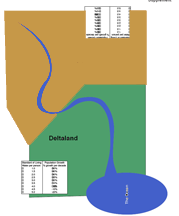Simulation #2
|
IN THIS GAME YOU HAVE CHOICES! Each country can determine how quickly it grows and how much it wants to invest in environmental control. Option Cards that you will draw determine what choices are available. As your country grows there will be more options, but also greater challenges. |
Appoint a mathematician who determines how many chips to move, an historian who records the history of the country that the game is simulating, and a facilitator who consults the rules and helps the team decide what to do. You will also want a negotiator who works when necessary with the other team. |
Shuffle and place the Option Cards face down on the Game Board. Start with two population counters in Upland and four in Deltaland. Calculate your standard of living: Upland begins with a standard of living of one water counter for each population counter. Deltaland begins with a standard of living of two water counters for each population counter. The rain is computed as before: for Deltaland, it is the roll of the dice or 8, whichever is smaller; for Upland, it is still three times the roll or 24, whichever is smaller. |
Here are the steps in each country’s move: [ Revision note: Need to simplify and follow some kind of narrative.] 1. Draw option cards. (The richer you are, the more options you have.) 2. Play all the bad news cards. 3. Trade, play, or hold onto the remaining cards. 4. Water evaporates from your dams. 5. Figure your water needs. 6. Reduce your water consumption. 7. Generate pollution. 8. Reduce pollution. 9. Consume water. 10. Send on your water. 11. Increase your population. 12. Discard cards that are not permanent. Look over the remaining cards for your country. If they are marked “one |
